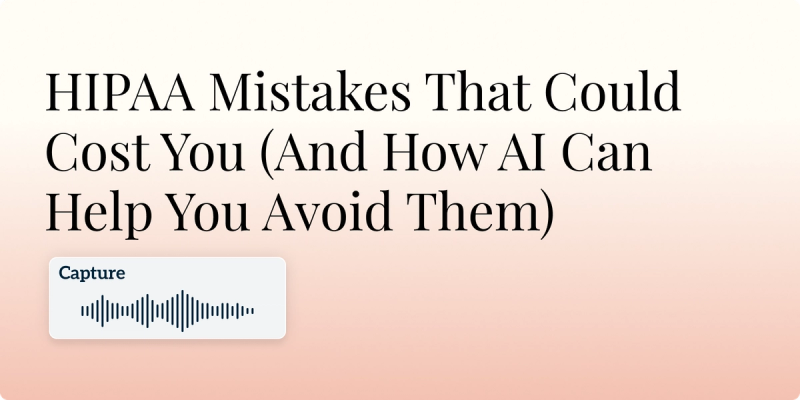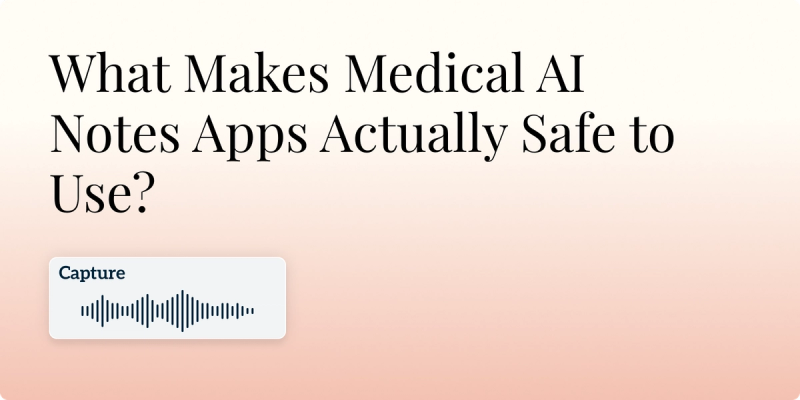
HIPAA Mistakes That Could Cost You (And How AI Can Help You Avoid Them)

TLDR
Key Takeaways:
- Accidental disclosures frequently stem from misdirected emails, unsecured messages, or misplaced devices, creating immediate reportable HIPAA breaches and forcing costly notification processes.
- Unsecured communication channels like personal phones or unencrypted email expose PHI to interception, violating the Security Rule and increasing the likelihood of regulatory penalties.
- AI scribes integrate encryption, privacy controls, and structured documentation into clinical workflows, minimizing oversharing and eliminating insecure or ad-hoc handling of PHI.
- Access controls with audit trails ensure only authorized staff engage with patient data while recording every access event, mitigating improper record viewing and supporting compliance investigations.
- Strategic implementation of AI tools, including workflow audits, staff training, and phased rollouts, helps organizations address their highest-risk compliance gaps and reinforce a culture of privacy.
A single HIPAA violation can trigger a cascade of consequences: staggering federal fines, reputational ruin, and a devastating loss of patient trust. In the high‑velocity environment of healthcare, a misstep is more than an error; it's a risk with seven‑figure potential. Yet, the core vulnerability for most organizations isn't malicious intent; it's the simple, inevitable reality of human error: a misdirected email, an accidental overshare, or even a misplaced laptop.
While human fallibility is a constant, a compliance disaster does not have to be. Explore critical HIPAA mistakes that put your practice at risk and how AI HIPAA Compliance tools act as a proactive safety net, catching common errors before they escalate.
Common And Costly HIPAA Mistakes
Navigating HIPAA compliance is fraught with potential risks. The most damaging breaches often stem from everyday errors rather than malicious cyberattacks. Understanding these common mistakes is the first step toward prevention.
1. The Accidental Overshare
This occurs when Protected Health Information (PHI) is sent to an unauthorized recipient.
- Example: A physician emails a patient's lab report to another specialist but selects the wrong “Dr. Smith” from the address book. Or, a front-desk staff member faxes a detailed treatment plan to the wrong number.
- The Risk: This is a direct, reportable breach of patient confidentiality. It can lead to patient complaints, mandatory breach notifications, and regulatory fines.
2. The Unsecure Communication
Using unsecured or personal communication channels to discuss patient care is a major vulnerability.
- Example: A nurse sends a text message about a patient's status to a colleague using a personal phone. Or, a doctor discusses a case with a consultant via unencrypted personal email.
- The Risk: These channels lack the required encryption and access controls. Making PHI easily interceptable and violating the HIPAA Security Rule, exposing data to unauthorized access.
3. Improper Access
This involves employees accessing patient records without legitimate treatment, payment, or operational need.
- Example: A staff member looks up the records of a neighbor, a celebrity, or a family member out of curiosity.
- The Risk: Even if no information is shared externally, this is a serious violation of patient privacy. It can lead to immediate termination, licensing board complaints, and severe penalties for the organization.
4. The Lost Device
The loss or theft of unencrypted devices containing PHI remains a top cause of data breaches.
- Example: A laptop, tablet, or USB drive with unencrypted patient files is left in a car or public place and is stolen.
- The Risk: If the device is unencrypted, the loss is considered a breach of unsecured PHI, triggering a mandatory breach notification process to patients and HHS.
From Human Fallibility to Automated Safeguards
The common thread in these costly mistakes is human error, a factor that is inevitable but no longer unmanageable. Traditional compliance is reactive, relying on manual audits that discover breaches long after they occur. AI HIPAA compliance flips this model, moving from a back‑office function to an integrated shield.
How An AI Scribe Acts As Your HIPAA Safeguard
An AI scribe does more than just take notes; it builds compliance directly into your documentation workflow. Here’s how a HIPAA-compliant scribe proactively prevents the aforementioned common HIPAA mistakes.
1. Automatic Secure Documentation
The scribe automatically documents the encounter with a secure, encrypted platform, never on a personal device or unsecured notepad.
- How it Works: From the moment the visit starts, the conversation is processed through a HIPAA-compliant system. All data is encrypted in transit and at rest.
- Result: Eliminates the risk of misplaced paper notes or insecure text messages about patient care.
2. Built-In Privacy Protection
The AI helps maintain privacy by keeping detailed session information within the secure clinical environment.
- How it Works: The scribe generates notes that stay within your secure EHR system. When sharing with referred providers, it creates structured, professional notes without sensitive details.
- Result: Reduces the risk of accidentally sharing more information than necessary.
3. Access Control and Audit Trail
The system maintains clear records of who accessed what patient information and when.
- How it Works: Your practice controls which staff members can access the AI Scribe and its notes. The system logs all access to patient encounters,
- Result: Creates a clear audit trail and prevents unauthorized staff from accessing patients' sessions they're not involved in.
4. Structured, Compliant Notes
The AI organizes information into a proper clinical format, helping ensure notes meet documentation standards.
- How it Works: The scribe structures information into standard SOAP or DAP format with appropriate clinical terminology, reducing ambiguity or non-compliant documentation.
- Result: Creates consistent, defensible documentation that supports appropriate billing and care coordination.
By handling these aspects automatically, an AI scribe lets you focus on your patient while maintaining compliance naturally throughout
Implementing AI Safeguards
Understanding AI’s potential is the first step; implementing it effectively is the next. A successful integration requires a strategic approach to avoiding non-compliance with AI.
- Audit your Workflow: Identify your biggest vulnerability points (e.g., is it internal snooping or external communication?).
- Choose Integrated Solutions: Look for AI features within your existing EHR or select dedicated compliance tools that integrate seamlessly.
- Prioritize Training: Educate your staff on both the common mistakes and how the new AI tools work with them to prevent errors, not to punish them. This fosters a culture of compliance and safety.
- Start with a Pilot: Consider rolling out one AI feature at a time, such as email scanning or access monitoring, to demonstrate value and refine the process before a full-scale implementation.
Conclusion
Ultimately, leveraging AI for HIPAA compliance transcends mere risk management. While avoiding devastating fines is a powerful incentive, the true value lies in building an unshakable foundation of patient trust. When you implement the right tool for you, one that proactively prevents oversharing, secures data, and monitors for misuse, you do more than just check a compliance box; you actively demonstrate your commitment to patient privacy and safety.
Frequently Asked Questions
ABOUT THE AUTHOR
Dr. Danni Steimberg
Licensed Medical Doctor
Reduce burnout,
improve patient care.
Join thousands of clinicians already using AI to become more efficient.

How Much Time Can You Save With an AI Scribe?
Reclaim your evenings and reduce burnout. See how an AI scribe automates documentation, giving you hours of your week back.

Top AI SOAP Note Tools in 2026 (Tested by Real Clinicians)
Discover Top AI SOAP Note Tools in 2026 - tested by real clinicians. Compare accuracy, EHR integrations, HIPAA/BAA, pricing, and use cases to pick the best fit.

What Makes Medical AI Notes Apps Actually Safe to Use?
Adopting AI notes is tempting, but is it safe? Here is a breakdown of non-negotiable features that truly protect your patients and your practice

